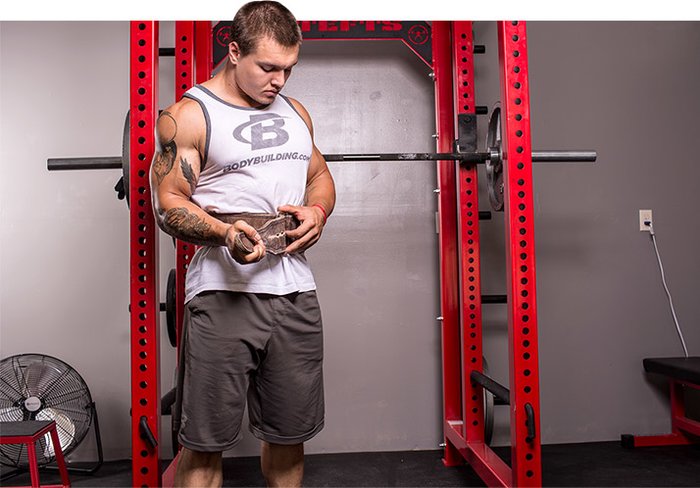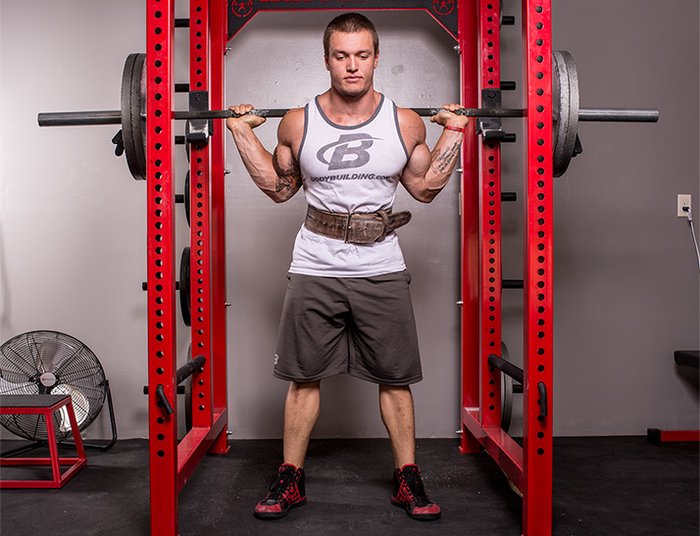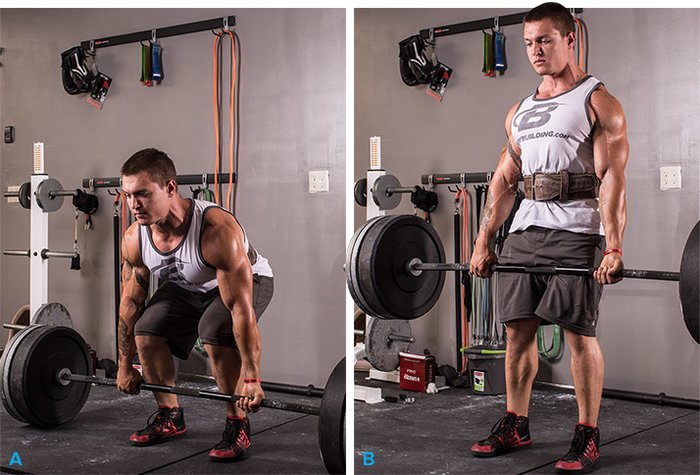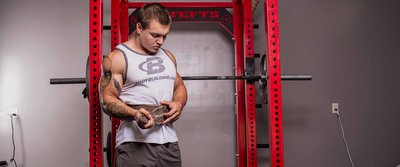"To belt or not to belt," Shakespeare might have asked were he writing today rather than 400-some years ago. It's a question any serious lifter asks at some point in their iron journey.
For the answer, you've come to the right place. I'll go over the most frequently asked questions about belts, and by the end of this article, you'll be able to make an informed decision on whether this tool is right for you.
Plus, you'll get extra brownie points for actually being able to use the belt correctly rather than aimlessly strutting around the gym with one on.
So let's get to it. Making decisions about lifting belts is a cinch once you know what you're doing.
Who Should—And Shouldn't—Wear a Belt?
A weightlifting belt is designed for just about anyone who aims to squat or deadlift as much as they possibly can. Pretty simple.

A weightlifting belt is designed for just about anyone who aims to squat or deadlift as much as they possibly can.
Who shouldn't wear a belt is a longer answer. You shouldn't use a belt if you:
Don't use a belt if you find it hinders your movement. If a belt affects how deep you can catch a clean or snatch, you'd probably be better served just to build your strength without a belt. In weightlifting, the low man usually wins.
Don't use a belt if you have a heart condition or other health condition that could be made worse by the increased blood pressure and intra-abdominal pressure induced by wearing a belt in the first place. This acute blood-pressure spike isn't problematic for most people, but those with health conditions or even a history of hernias probably shouldn't wear a belt (or use the Valsalva maneuver to forcefully exhale air with a closed glottis, for example). Your best bet is to first consult your doctor.
How Does a Weightlifting Belt Work?
The belt wraps around your abdomen, so that when you take a deep diaphragmatic breath (i.e., breathe into your stomach) the belt limits how far your abdomen can expand. This restriction intentionally increases intra-abdominal pressure, which in turn increases spinal stabilization.[1-3]
The increased stabilization increases how hard your prime movers—your legs and hips in a squat, for instance—can contract. Normally, your nervous system isn't too crazy about the idea of severing your spinal cord, so when it senses your back is at risk, it keeps your legs and hip from contracting quite so hard.
I think we can all agree that's a good thing.

Lifting with a belt theoretically should decrease risk of injury in the gym.
Assuming technique is the same, the belt allows these prime movers to contract harder. Further, a variety of studies show that wearing a belt helps you get through the sticking point of your squat faster, lift heavy loads with a higher average bar speed, activate your quads more through the sticking point of a squat, and fire your hamstrings more as you fatigue during a set.[1,4,5]
In essence, all of these things combined generally help you lift a bit heavier and activate more muscle fibers, which means you'll get a better training effect.
Further, lifting with a belt theoretically should decrease risk of injury in the gym—although I'm not aware of any studies looking into that directly, since ethics boards aren't usually too crazy about researchers intentionally herniating discs in the name of science. At the very least, it has been shown to decrease risk of reinjury in occupational settings.
Will Training With a Belt Make My Core Weak?
This is a common fear, and it's almost entirely baseless.
Wearing a belt during exercises, such as the squat and deadlift doesn't affect the activation of your rectus abdominis and external obliques muscles very much.[6] Most studies show slight increases; a few studies show very slight decreases. Taken altogether, the difference likely isn't enough to be physiologically relevant for two reasons:
It's nearly impossible to look at activation of deeper core muscles like the transversus abdominis and the internal oblique when someone's wearing a belt. There could be differences we can't see.
We haven't yet seen anything in the literature about how those contractions are coordinating to stabilize the spine.
In the broader view of core training, however, this is a nonissue. When compared to core-specific exercises like planks, crunches, and leg raises, even squats and deadlifts don't train your core very hard at all.
Comparing squats and deadlifts with and without a belt for core development is like comparing standing and seated dumbbell curls for quad development. The difference is so miniscule that it's not worth worrying about—unless you skip core-specific training entirely.
What Should I Look For When Buying a Belt?
A good belt made of sturdy leather will last decades, so don't be afraid to shell out $60-$100 for a good one, especially if you're a powerlifter, bodybuilder, or a general strength enthusiast.
For the most part, belts are not comfortable. Belts start off being very stiff and can take some time to be "broken in." Expect to get some bruising on the top of your hipbone or along your ribs from the belt digging into you during this process.

A good belt made of sturdy leather will last decades, so don't be afraid to shell out $60-$100 for a good one, especially if you're a powerlifter, bodybuilder, or a general strength enthusiast.
In general, the best belts for squats are 10-centimeters wide and 10-13-millimeters thick. Some people find that wider belts don't let them get into a good starting position for deadlift. If you're a competitive powerlifter, a leather belt tapered in the front (10 centimeters in the back and 5-7 centimeters in the front) helps with that issue. You may be better off getting two belts: one for squats and another for deadlifts.
If you're not quite that serious about it, you'd probably be better off just getting a tapered belt. It'll still do the job for squats—just not quite as well. Yet you won't be out of luck for pulls.
Another choice is a single-pronged buckle versus a double-pronged buckle. I generally recommend getting a single-pronged belt. Double-pronged belts look cool, but they can be annoying to put on and take off, and they're no more secure than a single-pronged belt.
Some belts latch and unlatch via a lever system, and they're faster to take on and off. However, many people like their belts a notch looser for deadlifts than for squats, and it takes a bit of time to reset the lever when you do each lift.
How Do I Use a Weightlifting Belt?
The first step is to set the belt. For many people, the belt sits just on top of their iliac crest (the top of the hip bone). When squatting, some people angle the belt up (above the belly button), some people have it going straight across, and some people angle it down (below the belly button). For deadlifts, it's usually either straight across or angled up—angling it down may interfere with getting into a good starting position.
Basically, this is more a matter of comfort than anything else. Start in whatever position is most comfortable. As you learn how to use it better, you may want to play around with different heights and angles to see what allows you to get your torso the tightest.

Basically, this is more a matter of comfort than anything else. Start in whatever position is most comfortable. As you learn how to use it better, you may want to play around with different heights and angles to see what allows you to get your torso the tightest.
After you set the belt, you'll need to adjust the tightness to find the right fit. You should use the tightest notch that still allows for a full intake of breath into your stomach, then try to press your stomach out against the belt. You know it's too tight if you can't get a full breath of air in or you have to elevate your shoulders to do so instead of solely expanding your torso.
On the other hand, if you can get a full breath on one notch but can still get a full breath on the next tightest notch, you're probably better off with the tighter one, at least for squats. Again, this is a matter of comfort, but many people prefer one notch looser for deadlifting because it allows them to assume a better starting position.
This article has been an adapted with permission from Greg Nuckols' article, "The Belt Bible," originally published on Strengtheory.com.
References
- Harman, E. A., Rosenstein, R. M., Frykman, P. N., & Nigro, G. A. (1988). Effects of a belt on intra-abdominal pressure during weight lifting. Medicine and Science in Sports and Exercise, 21(2), 186-190.
- Miyamoto, K., Iinuma, N., Maeda, M., Wada, E., & Shimizu, K. (1999). Effects of abdominal belts on intra-abdominal pressure, intramuscular pressure in the erector spinae muscles and myoelectrical activities of trunk muscles. Clinical Biomechanics, 14(2), 79-87.
- Lander, J. E., Simonton, R. L., & Giacobbe, J. K. (1990). The effectiveness of weight-belts during the squat exercise. Medicine and Science in Sports and Exercise, 22(1), 117-126.
- Zink, A. J., Whiting, W. C., Vincent, W. J., & McLaine, A. J. (2001). The effects of a weight belt on trunk and leg muscle activity and joint kinematics during the squat exercise. The Journal of Strength & Conditioning Research,15(2), 235-240.
- Lander, J. E., Hundley, J. R., & Simonton, R. L. (1992). The effectiveness of weight-belts during multiple repetitions of the squat exercise. Medicine and Science in Sports and Exercise, 24(5), 603-609.
- Warren, L. P., Appling, S., Oladehin, A., & Griffin, J. (2001). Effect of soft lumbar support belt on abdominal oblique muscle activity in nonimpaired adults during squat lifting. Journal of Orthopaedic & Sports Physical Therapy, 31(6), 316-323.

